Beckton to Riverside Sludge Mains Refurbishment (2017)
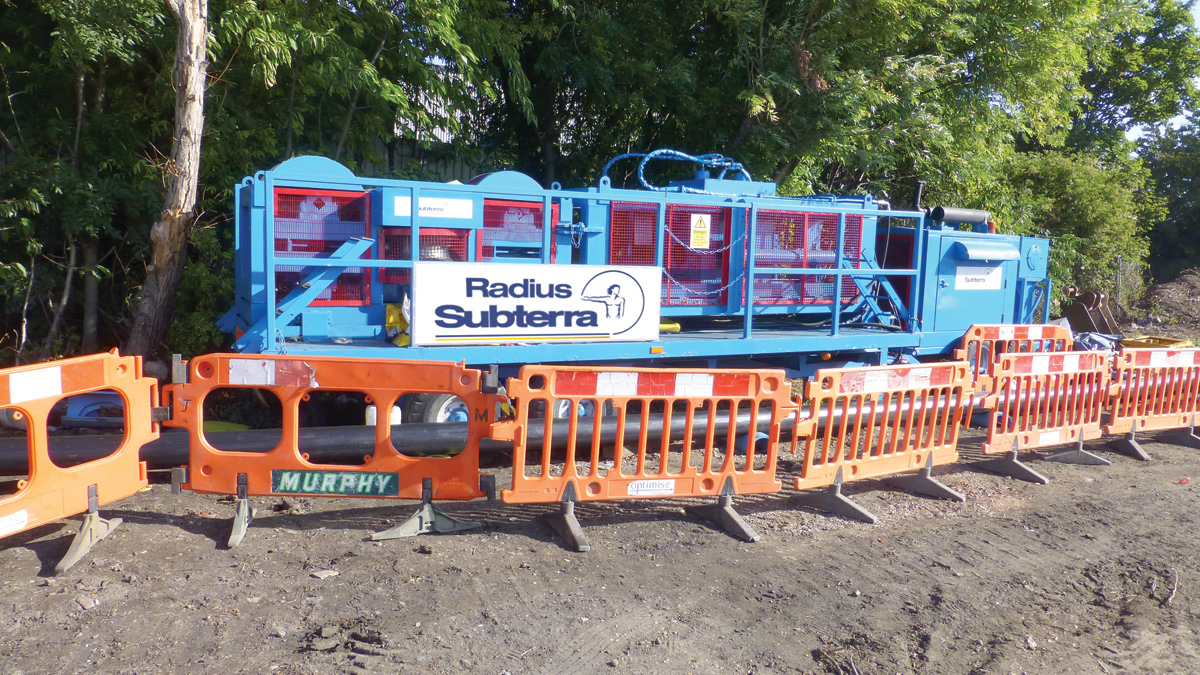
Radius Subterra’s Subline DR plant - Courtesy of Optimise
Thames Water Utilities Limited (TWUL) currently transfer a proportion of the wastewater sludge generated by Beckton Sewage Treatment Works (STW) in East London to Riverside STW using 2 (No.) 8km buried pipelines. These twin pipelines were originally installed in the late 1960s to pump sludge in the opposite direction from Riverside to Beckton where it was at the time removed by ship. As part of a project to install a new sludge treatment facility at Riverside, flows were reversed and new pumps were installed at Beckton to transfer sludge to Riverside where it is used to generate renewable energy.
The sludge pipeline
On leaving Beckton STW, the pipelines immediately cross under Barking Creek, which is a 100m wide tidal section of the River Roding just upstream of the Environment Agency (EA) flood barrier. On the east bank of the creek, the pipelines continue for a further 200m through a local nature reserve which is owned by the EA, before entering the Creekmouth industrial area at River Road.
The ageing pipelines have suffered recent bursts, which were expensive to repair and impacted TWUL’s customers. It was identified that any bursts along this 300m section would be environmentally catastrophic and any burst beneath the creek itself would be extremely difficult and expensive to repair. Due to the inherent risk posed to TWUL, Optimise (a JV comprising Barhale, Clancy Docwra, Murphy and MWH (now part of Stantec UK) to deliver part of TWUL’s AMP5 capital works programme) was engaged to carry out optioneering, design and construct a mitigation solution.

Original as-built drawing from 1968 showing the profile of the pipelines beneath the Barking Creek – Courtesy of Optimise
Optioneering
The twin 10” internal diameter (ID) welded steel pipelines were originally laid beneath the creek using an underwater trenching method. It is understood that the pipework was welded up as a long straight length on the east bank of the creek, then towed into the watercourse and sunk into the excavated trench. The profile of the pipework under the creek and its banks is therefore a long radius, curved inverted syphon.
Initially Optimise considered a number of different options to replace this section of pipework. These included:
- Installing new twin pipes under the creek using directional drilling.
- Installing a section of tunnel under the creek containing new twin pipework.
- Underwater trenching.
- Lining the existing pipelines.
Directional drilling was discounted due to the depth of the creek, ground conditions and a serious lack of working area on the west bank due to the presence of Beckton’s final effluent channel. Tunnelling was discounted due to cost, which would be significant given the depth of the creek. Underwater trenching was discounted due to the environmental implications to the watercourse and the proximity of other historic utilities buried beneath it, including two medium pressure gas mains. Lining the existing pipelines was selected as the preferred option as it would minimise impact on this sensitive area and be the most cost effective.
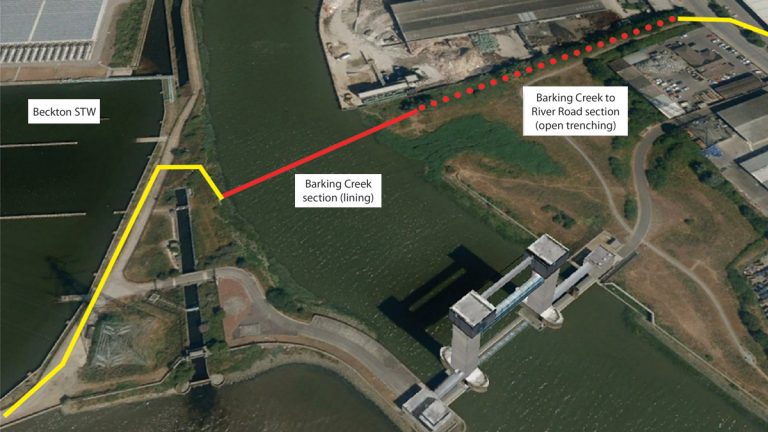
Barking Creek (Google Earth Imagery) – Courtesy of Optimise
Design of the lining system
The lining system specification included the requirement for it to be fully structural, pressure rated to at least 6bar(g) and provide a ‘close fit’ solution to minimise the reduction in diameter and therefore hydraulic capacity. A number of different systems were considered before Radius Subterra’s Subline DR system was selected by the Optimise Design Team.
This system involves concentrically reducing the diameter of a length of polyethylene pipework by pushing it through specially designed rollers. This action reduces the diameter of the PE liner pipe to a stable size, approximately 7-10% less than the original, allowing it to be inserted into a host pipe whose internal diameter closely matches the original external diameter of the liner pipe. Following insertion, the liner pipe is returned to its original diameter using water pressure, enabling a ‘close fit’ to be achieved.
The polyethylene pipework selected to line the 10” (254mm) ID existing pipework was 250mm outside diameter (OD) SDR17 PE100. Between the creek and River Road where a reduction in diameter was not necessary, the pipework was specified as 315mm OD SDR11 PE100 polyethylene, which would be laid parallel to the existing mains for 200m, connecting back into them immediately upstream of River Road. Although more straightforward, the design of this section had to take into account the crossing and reinstatement of an EA flood defence embankment.
In order to confirm the implications of lining the twin sludge mains on the hydraulic performance of the system, Optimise carried out a pump performance review of the pipelines. This review was based on building the new proposals into a model of the existing system, which was developed using a large number of as-built drawings for the twin pipelines, historic reports, site visits to view the pumps in operation and information provided by TWUL Operations.
The system is designed to pump a blend of surplus activated and primary sludge of between 1.25-2% dry solids using 3 (No.) variable speed pumps installed in a duty/assist/standby arrangement. It was determined that the proposed diameter reduction and the small reduction in flow rate it induces would not place any significant restriction on the current and future sludge management processes employed by TWUL Operations. Lining the section between the creek and River Road was also investigated, however the associated reduction in flow rate was deemed too significant.
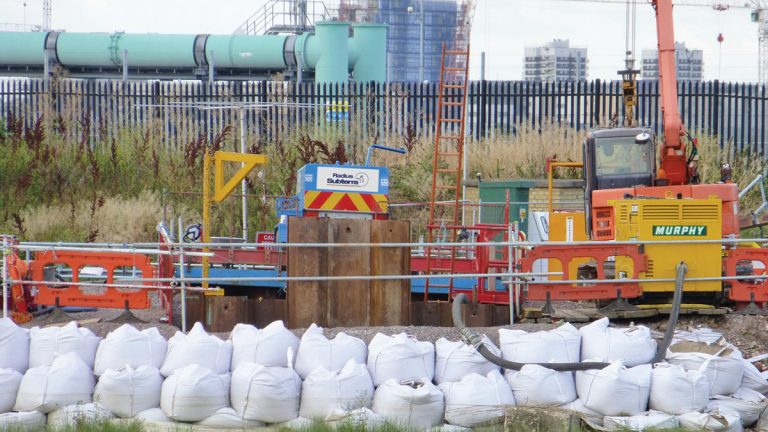
The temporary flood defence structure and winch equipment setup on the west bank of the creek – Courtesy of Optimise
Survey
To confirm suitability of the lining system and minimise risk, it was essential that the twin pipelines were carefully surveyed to understand their alignment and condition. However, before the pipelines were surveyed intrusively, a series of non-destructive tests (NDT) were carried out to understand current condition and minimise the risk of causing bursts during the survey phase.
Following positive NDT results, each pipeline was isolated in turn through liaison with TWUL Operations. This maintained the supply of sludge down one main at all times whilst the other was cleaned and surveyed. The surveys included CCTV and laser scanning.
This confirmed the ovality, expected alignment of the pipes and also identified that they had been originally lined using bitumen.
This bitumen liner was found to be in a poor condition and could be seen to be protruding from the pipe wall in places. These protrusions would therefore need to be removed before lining to ensure smooth insertion. Following careful examination of the results of the surveys by Optimise and Radius Subterra, it was concluded that the installation of the Subline DR system was feasible and that the level of risk to Optimise and TWUL would be acceptable.
Construction
The lining process itself was undertaken in a matter of hours; however to enable it, approximately two months of preparatory activities were carried out. Extensive temporary works were required including a 4m wide x 8m long x 3m deep caisson on the east bank to allow the liner pipework to be inserted. On the west bank, a 4m long x 4m wide x 3m deep caisson was required to enable winching and to receive the liner pipes.
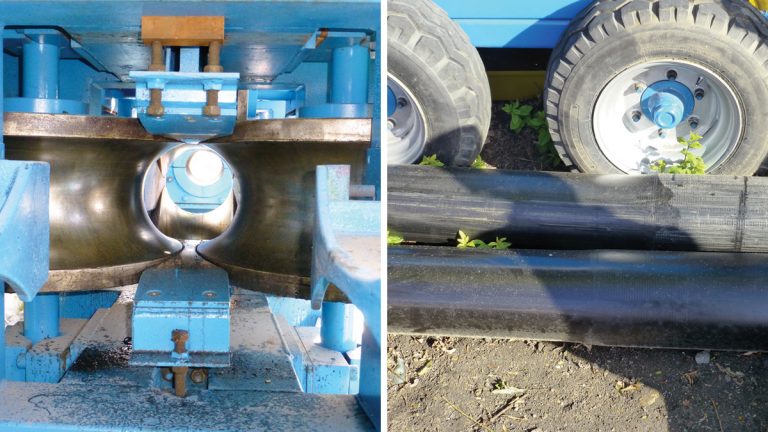
(left) Radius Subterra’s specially designed pipe rollers and (right) section of pipework showing the stable concentric reduction in diameter – Courtesy of Optimise
The installation of this caisson was particularly challenging as it needed to be located around twin 90° bends on the existing pipework, which could not be negotiated by the liner. Surveys located these bends to be very close to Barking Creek’s high water line. Excavation at this location therefore required significant planning and a temporary flood defence structure to be constructed around the caisson. The temporary works design for this installation was developed and agreed with both the Port of London Authority (PLA) and the Marine Management Organisation (MMO).
With the temporary access points constructed, the first host pipe was isolated, drained down, cleaned and the bitumen liner protrusions removed. The liner pipework was then reduced in diameter and winched into place through the host pipework under the creek. Following successful installation, the liner pipework was reverted to its original diameter and connected to the existing pipework on the west bank using bespoke fabricated steel bends to replace the existing 90° bends. The first pipe was then commissioned and put back into service to maintain flow whilst the same process was carried out on the second pipe. The 200m section of twin pipework between the creek and River Road was replaced using conventional open trenching offline of the existing pipework and a twin air valve chamber was constructed at the high point.
Health and safety constraints
There were a number of constraints on the excavation of the two temporary caissons and the 200m section of open trenching which had to be managed for the duration of the works. This included two medium pressure gas mains (24” and 6”) within the working area running parallel with the existing pipelines. Optimise carried out extensive site investigation and careful liaison with National Grid in relation to these assets. The working area was also deemed by unexploded ordinance experts to be at significant risk of historic devices being present and therefore required specialists to carry out magnetometer surveys prior to all excavation.
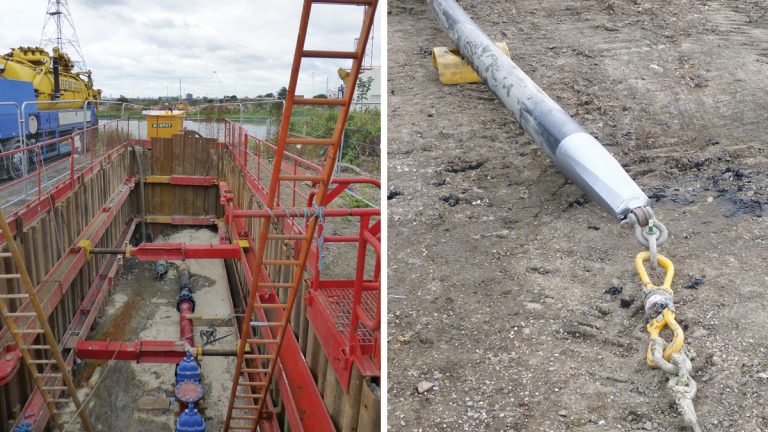
(left) The temporary caisson on the east bank of the creek and the first main about to be lined with Barking Creek in the background and (right) liner pipework ready for installation with towing head attached – Courtesy of Optimise
Working in such close proximity to the tidal Barking Creek also brought some unique challenges in terms of the risk of excavations flooding. This was managed through monitoring meteorological forecasts, tide data and through discussions with the EA, MMO and PLA. The industrial history of the area triggered an extensive suite of soil testing during the site investigation phase to identify and rule out any potential contaminated land risks to Optimise’s workforce.
Customer care
The project was subject to lengthy permission processes from a number of stakeholders as the area is particularly sensitive due to it being one of the limited public amenities within a heavily industrialised area of London. Through liaison with local businesses, the general public and the Creekmouth Preservation Society, Optimise ensured that their interests were safeguarded and where possible the area was enhanced.






